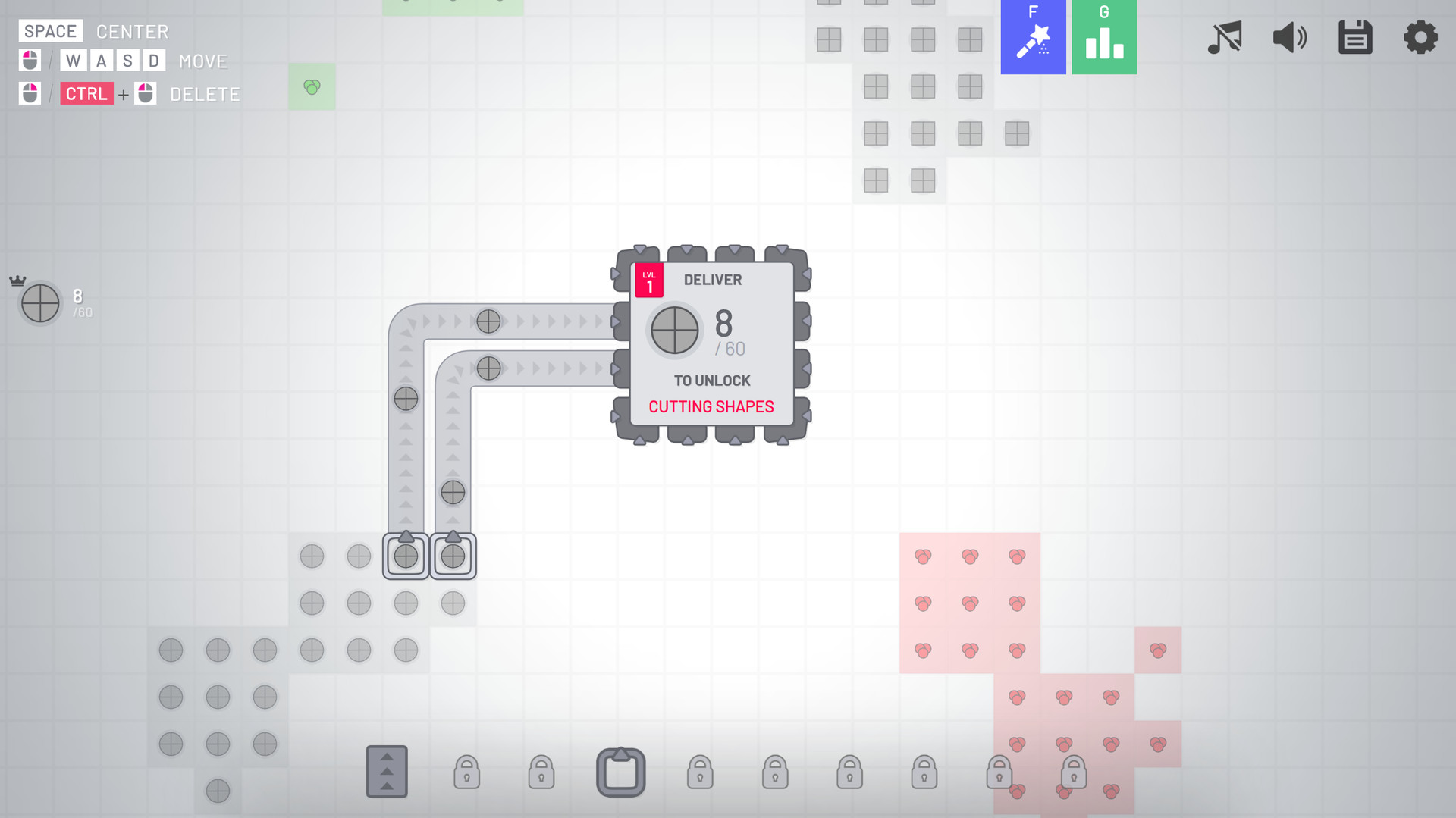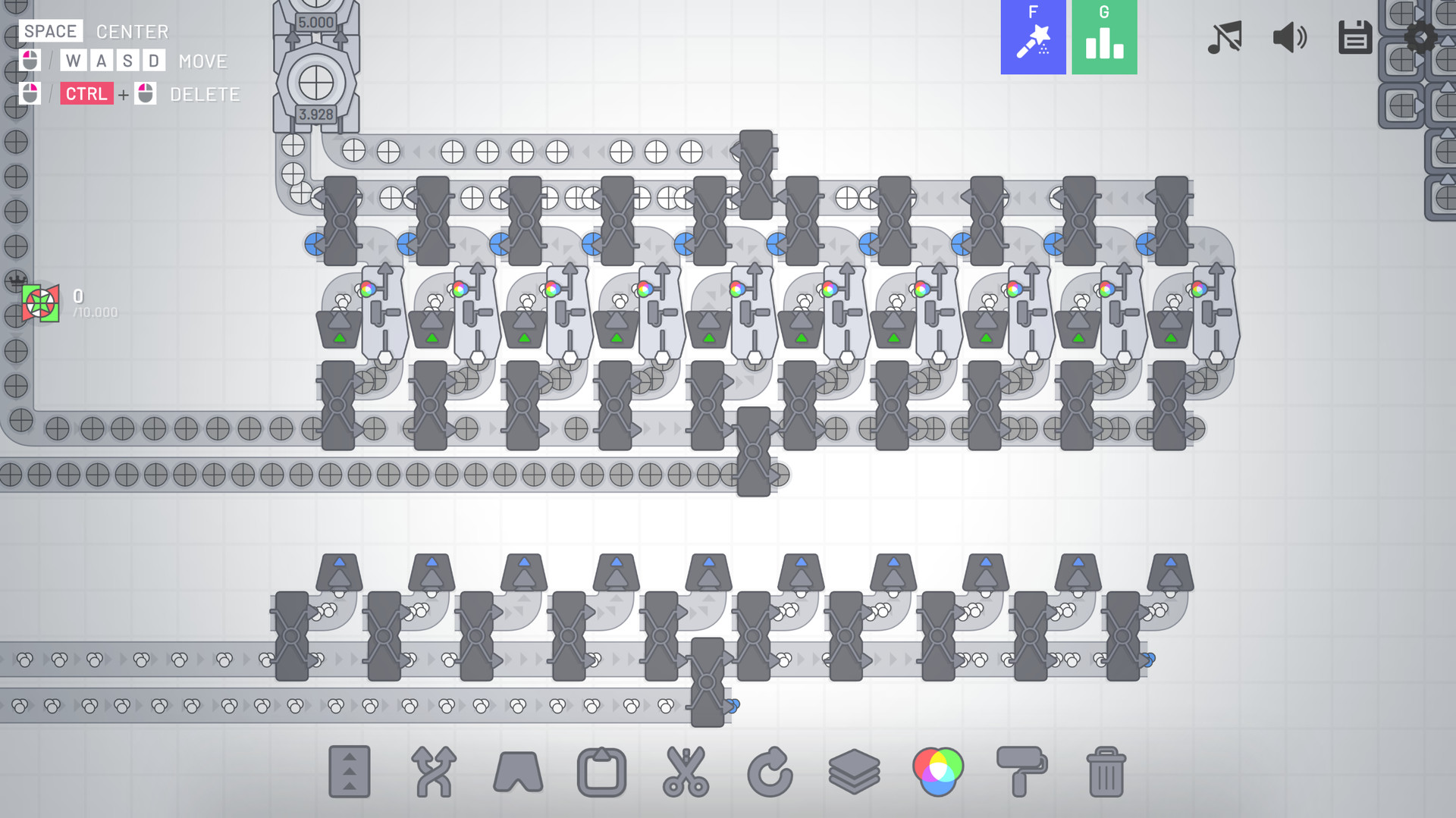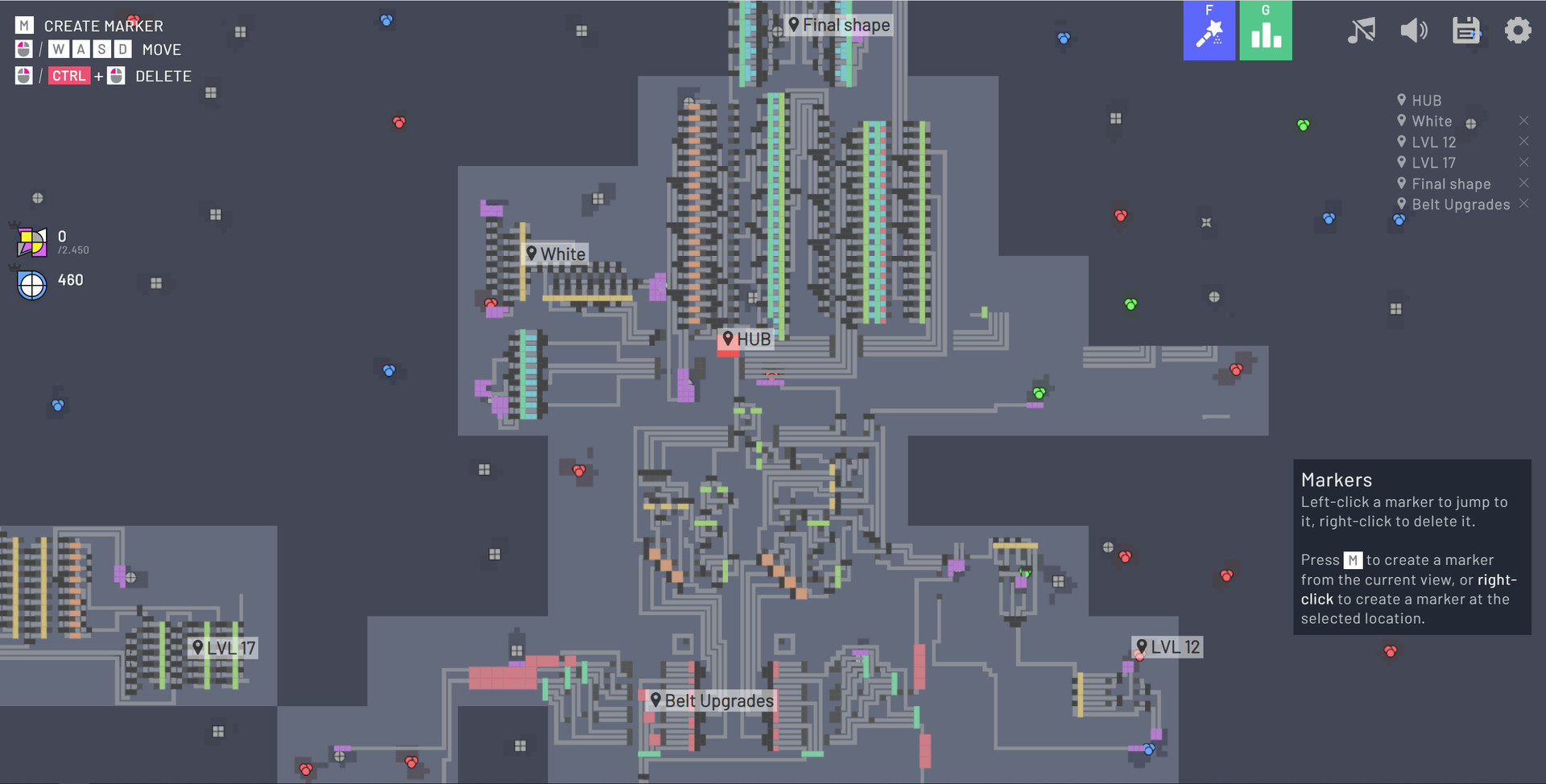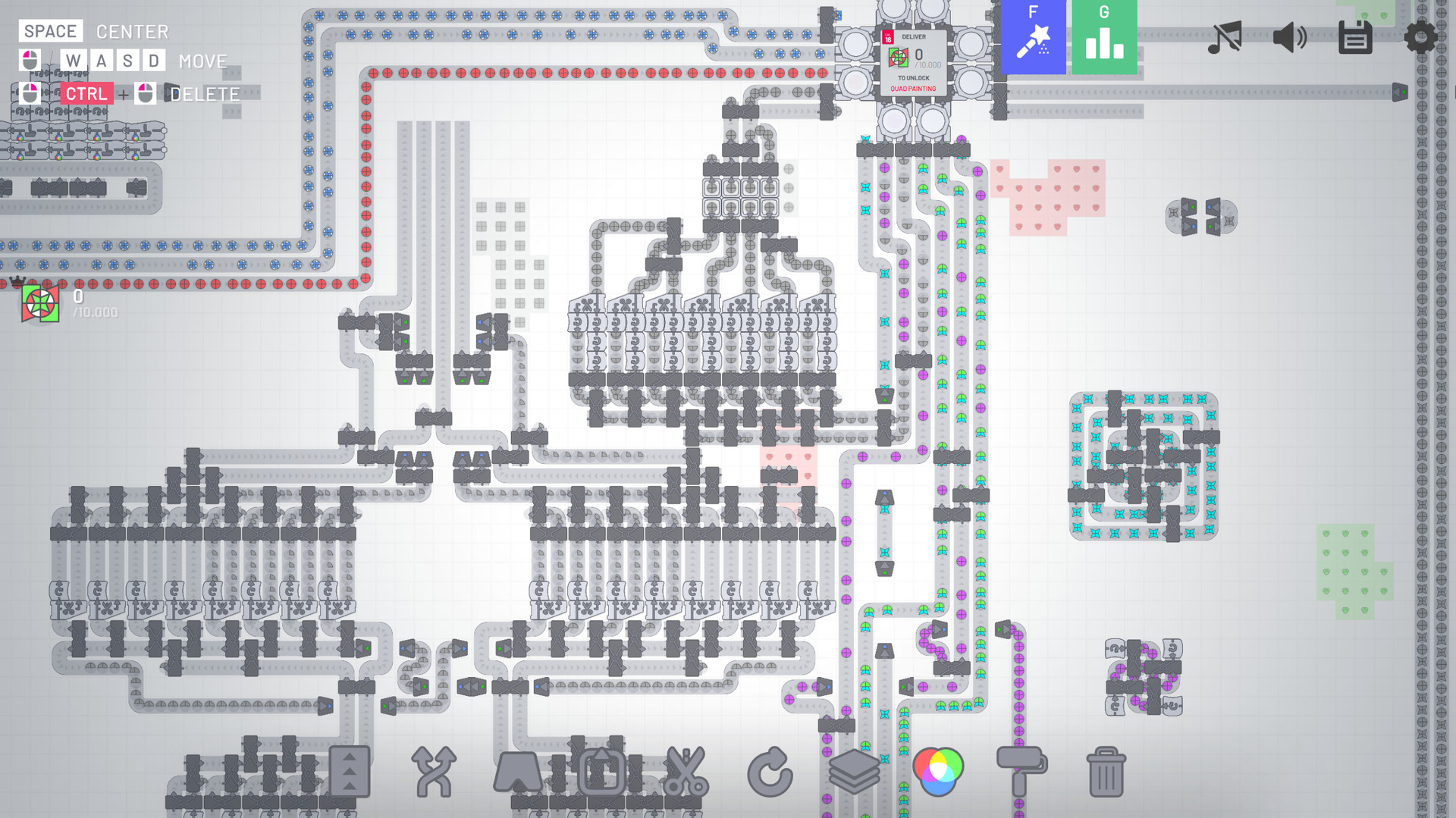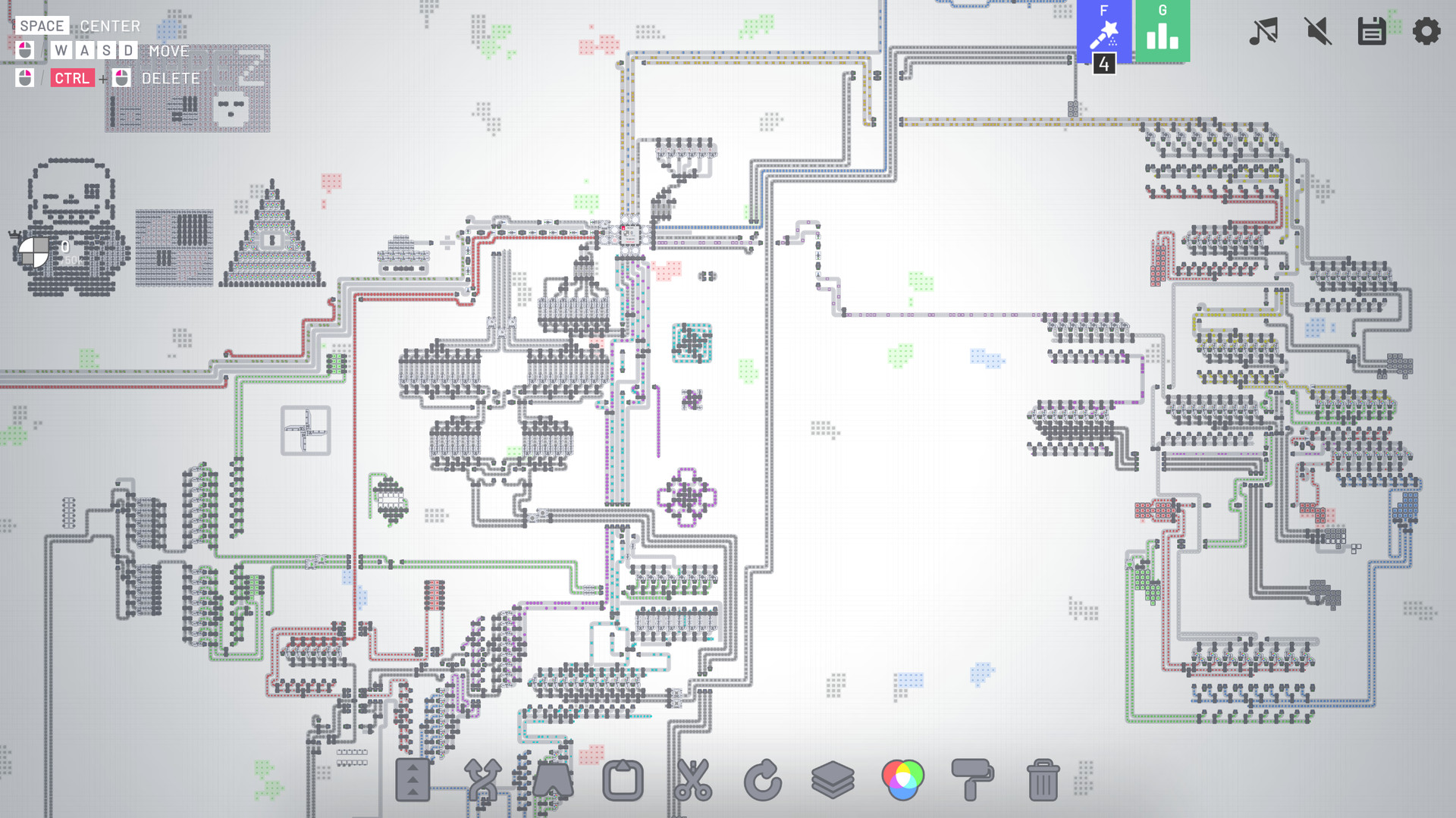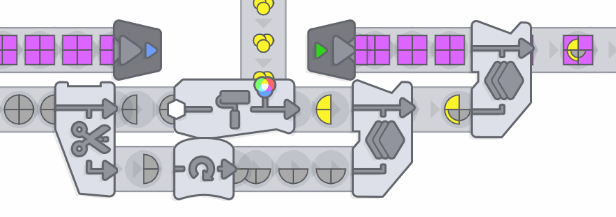
shapez.io is a game about building factories to automate the creation and combination of shapes. Deliver the requested, increasingly complex shapes to progress within the game and unlock upgrades to speed up your factory.
Since the demand raises you will have to scale up your factory to fit the needs - Don't forget about resources though, you will have to expand in the infinite map!
Since shapes can get boring soon you need to mix colors and paint your shapes with it - Combine red, green and blue color resources to produce different colors and paint shapes with it to satisfy the demand.
This game features 18 levels (Which should keep you busy for hours already!) but I'm constantly adding new content - There is a lot planned!
Standalone Advantages
- Waypoints
- Unlimited Savegames
- Dark Mode
- More settings
- Allow me to further develop shapez.io ❤️
- More features in the future!
This game is open source - Anybody can contribute! Besides of that, I listen a lot to the community! I try to read all suggestions and take as much feedback into account as possible.
- Story mode where buildings cost shapes
- More levels & buildings (standalone exclusive)
- Different maps, and maybe map obstacles
- Configurable map creation (Edit number and size of patches, seed, and more)
- More types of shapes
- More performance improvements (Although the game already runs pretty good!)
- Color blind mode
- And much more!
Hello everyone!
A popular point of feedback on the demo was the research system. It's kinda a hassle to navigate and you couldn't really play how you want to play, unlock what you want to unlock. We went back to the drawing board and took another look at the research system, There's a new system now, and we'd like to explain it to you! However, we think it would be interesting to walk you through the history of the research system.
If you'd just like to read about the newest system, feel free to skip to design #4.
So to get where we are now, we had to make a number of iterations of the research system, see what elements worked and which didnt and then improve upon that iteration by making a new, hopefully better one. Lets walk you through these iterations, so you have a good idea of our progress!
Design #1: The initial research tree
Way back when, the research system had a classic tree structure connecting one research to the next. Every research could require multiple previous ones and each and every individual building and building variation had a unique research youd have to unlock.

While such a research tree would be functional in the end youd have everything this design brings a couple of major problems.
Features were extremely broken up. You had to complete multiple separate researches to unlock all the bits and pieces of a single mechanic. You could make painters but wouldnt have a way to move paint around to make use of the new unlock. Youd also be missing out on a lot of quality of life features that make building a lot easier, so you waste a lot of time and space building elaborate factories while a single unlock would make that system a lot easier and compact to work with.
The researchperbuilding system also means the tree would be extremely large and overwhelming. It was hard to find out what exactly you were working towards, if you could even find what youre working on right now.
What we needed was a new tree design that combined various buildings into single researches to make the tree more compact and easier on the eyes.
Design #2: Main progression line with categorized subtrees
For this design, we went with a linear research tree a tree trunk, you could say. Core elements such as rotators and stackers would be right at the top and the main mechanic you unlock when completing the research. Many of the smaller bits and pieces were unified as part of these core unlocks to make sure you unlock all the necessary buildings you need for the main new mechanic.

Other unlocks that werent part of the core mechanics would be in separate, smaller subtrees. Youd have a subtree for belt speed, one for building speed, one for blueprints, etc. This removed the clutter from the main tree and organized all the other unlocks in separate tabs.
This design made it a lot easier to see the next big thing you were working towards, and made it impossible to miss any core mechanics youd need to progress the game. The fact that youd immediately have all the elements you needed to fully enjoy the new mechanic prevented a lot of frustration that came with the old design.

However, this design too came with issues. The splintered subtrees would still make it difficult to find some researches, since some researches could fit in multiple categories. Is fluid packing part of fluids, or part of transport? It also made it difficult to keep track of your progression across subtrees: you sometimes had to flip through multiple tabs to find out what you just unlocked and where a new research had just become available.
Additionally, it was hard to understand the connection between the main progression line and the subgoals. The small trees give you a general impression of what you had to do to progress unlock one belt speed increase to unlock the next increase but subgoals also needed you to progress the main progression line at times. The only way to find out about this was to guess. Cant progress this subtree? Got to be the main line.

The tree-like design also just didnt really add much. Some researches would be locked behind other researches just for the sake of looking like a tree. You had to unlock the CCW rotator before you could unlock the 180 rotator, even though you can definitely do without the former to use the latter.
To add insult to injury, some unlocks most would consider essential and were huge QoL improvements were spread across these subtrees. You had to go out of your way to unlock splitters and mergers for example, and while you could technically progress without them, it made complex factories unnecessarily painful and inefficient to build.
While this iteration fixed a lot of the issues of the first design, it brought a whole host of other issues to light. So, we went back to the drawing board.
Design #3: Milestones & Side goals
We decided to ditch the trees and go with stones instead. This new design consolidated the main progression line into milestones: bigger, more meaningful unlocks. Every milestone you reach is like a whole new world of options and side goals to explore. The tree structures and all the separate tabs were completely removed and everything was centralized within the new milestones. Essential quality of life unlocks like mergers and splitters are now unlocked from the start, and more minor unlocks could be found behind optional side goals you unlock with the milestones.

It was now extremely easy to understand when you unlock what mechanic and when new side goals become available. You have complete freedom in choosing what side goals you want to take on, as you no longer have to unlock full cutters to unlock the swapper, for instance. Milestones are now the only dependency.
This iteration of the research system is the one currently seen in the demo. While it worked well enough for the part you could play in the demo, some issues started popping up here and there. Thank you again for all the feedback!

The big issue here is that the progression of the shape you needed to make to unlock the milestones didnt really progress in a logical way. The required shapes were too different from each other, and with the limited space available especially before you unlock space platforms it required you to demolish your previous work to make space for the new production line. This process is very mentally draining and doesnt feel as rewarding as it could. The milestones should incentivise growth, not feel like a rogue-lite game.
Additionally, the long, single line of milestones made it difficult to keep track of all the available and completed side goals. You had to navigate back and forth constantly to find the ones you wanted. Again, since the demo wasnt that large, this isnt that big of a deal yet. When all the milestones become available in the full game however, finding anything will be a struggle. Adding more goals to the game would be a challenge as well as theyre tied 1:1 to the milestones, but it would also make the previous problem worse.
Design #4: Evolving milestones & Side tasks progression
With all that in mind, we move on to the research system thats currently available in the latest Patreon-exclusive Alpha. We stick with the milestone system, but have made a handful of big changes.
Milestone goals are no longer limited to one shape type. Some goals may have multiple shape requirements that either build upon shapes you had to deliver previously or will be reused in a future goal. This is a fairly standalone change, but theres more.

Introducing: Research Points. Optional unlocks, like belt speeds and blueprint limits, are no longer tied to goals. Instead, youll be rewarded Research Points by completing Side Tasks, which in turn are unlocked by reaching new milestones like before. These side tasks start off simpler than milestones, but you unlock new, more difficult side tasks by completing them. These side tasks lines (name pending) can have between 3 and 7 tasks and will continue to ramp up in difficulty until you reach the end of the line. Side tasks can also award other minor rewards alongside research points, like extra blueprint points and platform limits.

The research points you obtain can be spent on whichever upgrade you like as long as you have completed the milestone to unlock the mechanic you want to upgrade. All possible upgrades are now on one dedicated screen a shop, as it were instead of being tied to a long, single row of milestones. You can really go wild with your research points: want to max out belt speed in the early game? If you can afford it, its yours.

This system is quite a big departure from the iterations we had before, but it brings a lot of improvements to the unlocking experience. Milestones now feel even more important and rewarding to unlock. They clearly show what you get by unlocking them, without being bloated by small upgrades. The research points and the shop where you unlock upgrades gives you both a lot of freedom to play how you want to play and also makes it a lot more clear what upgrades are available. This also helps make the game more replayable you could decide to focus on different upgrades and challenge yourself in new ways.
The new system is clearly the perfect solution to all current and future problems and will never have to be improved ever again! is what we tell ourselves to sleep at night.
Joking aside, wed love to hear your feedback on the new research system. It wont be added to the demo, but it is currently available to Patreon supporters.
[hr][/hr]
With all these iterations, the research system of shapez 2 is the single most reworked element in the game. Its really important to get this right. The game should feel both challenging and rewarding, without being frustrating. We will continue to tweak this system until we nail the balance!
That's the devlog! We hope you enjoyed reading about the history and old designs of the research system. See you again soon!
~ Tobias & the shapez 2 team
Be sure to wishlist shapez 2 and play the demo!
https://store.steampowered.com/app/2162800/shapez_2/Join the community:
X / Twitter YouTube Discord Reddit TikTok Patreon[ 6406 ]
[ 6040 ]
[ 2652 ]
[ 4909 ]

